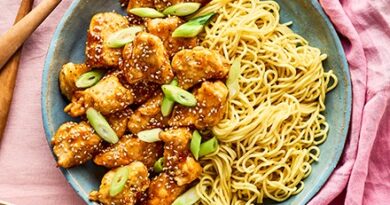Rediscovering Health with the Paleo Diet Plan: A Comprehensive Guide
In the quest for better health and well-being, many people are turning back the clock to explore the dietary habits of our ancestors. The Paleo diet, rooted in the eating patterns of the Paleolithic era, offers a blueprint for consuming whole, unprocessed foods that our bodies are naturally designed to thrive on. This guide will delve deep into the Paleo diet, exploring its principles, benefits, and practical steps for incorporating it into your lifestyle.
Understanding the Paleo Diet Plan:
The Paleo diet, often referred to as the Paleolithic or Caveman diet, is based on the idea that our bodies are best suited to the foods that our pre-agricultural ancestors consumed. This means focusing on foods that can be hunted, fished, and gathered. The primary components of the Paleo diet include:
- Lean meats: Emphasize grass-fed beef, pasture-raised poultry, and wild game.
- Fish and seafood: Prioritize fatty fish like salmon and mackerel for their high omega-3 content.
- Fruits and vegetables: Incorporate a variety of fresh, colorful produce, from berries and apples to leafy greens and root vegetables.
- Nuts and seeds: Snack on almonds, walnuts, and seeds such as flaxseeds and chia seeds.
- Healthy fats: Use natural fats like olive oil, coconut oil, and avocado oil for cooking and dressing.
Foods to Eliminate:
Adhering to the Paleo diet requires avoiding foods that became prevalent with the rise of agriculture and industrial food processing. These include:
- Grains: Such as wheat, rice, oats, and other cereals.
- Legumes: Including beans, lentils, peanuts, and soy.
- Dairy: Such as milk, cheese, yogurt, and butter.
- Processed foods: Avoid refined sugars, artificial sweeteners, and trans fats.
- Refined vegetable oils: Stay away from canola oil, soybean oil, and corn oil.
The Benefits of the Paleo Diet Plan:
- Weight Loss and Management:
The Paleo diet naturally reduces the intake of high-calorie, nutrient-poor foods, which can lead to weight loss. The focus on protein and healthy fats helps maintain satiety, reducing the likelihood of overeating.
- Improved Blood Sugar Regulation:
By eliminating refined sugars and processed foods, the Paleo diet helps stabilize blood sugar levels. This can significantly reduce the risk of developing type 2 diabetes and improve insulin sensitivity.
- Enhanced Digestive Health:
Consuming whole, unprocessed foods promotes better digestive health. Many people find relief from digestive issues by eliminating grains and legumes, which contain anti-nutrients like lectins and phytic acid that can irritate the gut.
- Sustained Energy Levels:
The Paleo diet emphasizes nutrient-dense foods that provide steady energy throughout the day, preventing the energy crashes that are common with high-carb diets.
- Reduced Inflammation:
The diet’s focus on omega-3 fatty acids from fish and healthy fats from nuts and seeds can help reduce inflammation, a key factor in chronic diseases such as heart disease, arthritis, and autoimmune conditions.

Embarking on the Paleo Diet Journey:
- Stock Your Pantry with Paleo Essentials:
Begin by purging your kitchen of non-Paleo items and restocking it with Paleo-friendly foods. Visit local farmers’ markets for fresh produce and seek out sources of grass-fed meats and wild-caught seafood.
- Plan and Prepare Your Meals:
Meal planning is crucial for success on the Paleo diet. Start your day with a vegetable-packed omelet and avocado. For lunch, enjoy a hearty salad with grilled chicken and an array of colorful vegetables. Dinner can be a satisfying grass-fed steak with a side of roasted root vegetables.
- Experiment with Paleo Recipes:
The internet is brimming with creative and delicious Paleo recipes. Try making Paleo-friendly versions of your favorite dishes, such as cauliflower rice stir-fry, zucchini noodles, or almond flour pancakes.
- Stay Hydrated:
Proper hydration is essential on the Paleo diet. Drink plenty of water throughout the day, and consider herbal teas and coconut water as additional hydration options.
- Tune Into Your Body’s Signals:
Adopting the Paleo diet is a highly individualized experience. Observe how your body reacts to dietary changes and tweak your food choices accordingly. Since nutritional needs vary from person to person, it’s crucial to identify and follow what optimally supports your health and well-being.
Overcoming Challenges on the Paleo Diet:
- Dealing with Cravings:
Cravings for non-Paleo foods can be challenging, especially in the beginning. Combat cravings by keeping Paleo-friendly snacks on hand, such as nuts, seeds, and fruit. Experimenting with Paleo baking can also provide satisfying alternatives to traditional sweets.
- Eating Out:
Dining out while following the Paleo diet requires some planning. Choose restaurants that offer fresh, whole foods and don’t hesitate to ask for modifications. Opt for salads, grilled meats, and vegetables, and avoid sauces and dressings that may contain non-Paleo ingredients.
- Social Situations:
Navigating social events can be tricky, but it’s possible to stick to your diet with a bit of preparation. Bring a Paleo dish to share or eat a small meal before you go to avoid temptation.
Long-Term Sustainability:
The Paleo diet is more than a temporary eating plan; it’s a lifestyle change. To sustain it long-term, focus on variety and balance in your meals. Incorporate seasonal fruits and vegetables to keep your diet interesting and aligned with nature’s cycles. Engage with the Paleo community for support, recipe ideas, and motivation.
Conclusion:
The Paleo diet offers a return to a simpler, more natural way of eating that aligns with our evolutionary biology. By focusing on whole, nutrient-dense foods and eliminating processed items, the Paleo diet can help you achieve better health, sustained energy, and a more balanced lifestyle. Whether you’re looking to lose weight, improve your digestive health, or simply eat more nutritiously, the Paleo diet provides a sustainable and satisfying approach to modern nutrition. Embrace the journey, listen to your body, and enjoy the myriad benefits of eating like our ancestors.
FAQs:
- What is the Paleo diet?
The Paleo diet is a nutritional plan based on the presumed diet of our Paleolithic ancestors. It emphasizes whole, unprocessed foods such as lean meats, fish, fruits, vegetables, nuts, and seeds while excluding grains, legumes, dairy, and processed foods.
- What foods are allowed on the Paleo diet?
- Lean meats (preferably grass-fed)
- Fish and seafood (especially fatty fish like salmon)
- Fresh fruits and vegetables
- Nuts and seeds
- Healthy fats (olive oil, coconut oil, avocado)
- What foods should be avoided on the Paleo diet?
- Grains (wheat, rice, oats)
- Legumes (beans, lentils, peanuts, soy)
- Dairy products (milk, cheese, yogurt)
- Processed foods and refined sugars
- Refined vegetable oils (canola, soybean, corn oil)
- What are the benefits of the Paleo diet?
- Weight loss and management
- Improved blood sugar control
- Enhanced digestive health
- Sustained energy levels
- Reduced inflammation
- Can I follow the Paleo diet if I’m vegetarian or vegan?
The Paleo diet is primarily meat-based, but it can be adapted for vegetarians by focusing on plant-based proteins such as nuts, seeds, and certain vegetables. Vegans may find it more challenging due to the exclusion of legumes and grains, but incorporating a variety of Paleo-friendly plant foods can help meet nutritional needs.
- Is the Paleo diet suitable for athletes?
Yes, the Paleo diet can be beneficial for athletes as it provides high-quality proteins, healthy fats, and nutrient-dense carbohydrates from fruits and vegetables, which can support muscle repair, energy levels, and overall performance.
- How do I start the Paleo diet?
- Clear out non-Paleo foods from your kitchen.
- Stock up on Paleo-friendly foods.
- Plan your meals and experiment with Paleo recipes.
- Stay hydrated and listen to your body’s signals.
- Adjust as needed to suit your personal nutritional needs.
- Can I eat Paleo on a budget?
Yes, it’s possible to follow the Paleo diet on a budget by prioritizing seasonal and local produce, buying in bulk, choosing less expensive cuts of meat, and cooking at home to avoid processed convenience foods.
- Are there any potential side effects when starting the Paleo diet?
Some people may experience initial side effects such as fatigue, headaches, or digestive changes as their body adjusts to the new diet. These symptoms are usually temporary and can be mitigated by staying hydrated and ensuring adequate nutrient intake.
- Is the Paleo diet sustainable long-term?
The Paleo diet can be sustainable long-term if approached with variety and balance. Incorporating a wide range of Paleo-friendly foods and adapting the diet to fit individual needs can help maintain interest and nutritional adequacy over time




